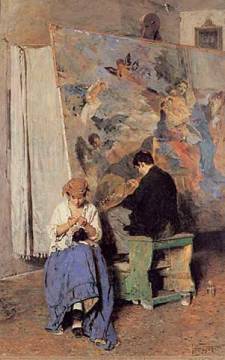Giacomo Favretto (Venetian 1849-1887) was a 19th century painter who specialized in warmly anecdotal scenes of regular Venetians going about their work and play.
Favretto got his start working for a pittance in a stationer's shop cutting silhouettes out of black paper, when a wealthy person discovered him and set him up at the Venice Academy.
Favretto studied plenty of old masters at the Venice Academy with Pompeo Molmenti, and he also studied in Paris, but Favretto and other artists of his generation felt that the grand, serious compositions of mythological or historical figures was out of date.
According to a 1902 book called The History of Modern Italian Art, he soon developed an independent style inspired by the younger artists of Venice such Domenico Morelli.

 |
| "The Defect is in the Handle" 1881, by Giacomo Favretto |
According to a 1902 book called The History of Modern Italian Art, he soon developed an independent style inspired by the younger artists of Venice such Domenico Morelli.

Subjects were taken from everyday life, ordinary people at work and play rather than mythological or historical figures. The paint surface alternates finished areas with loose sketchy passages, suggesting an improvisational approach to composition.
Favretto painted large areas of quiet colors, such as grays and browns, a patch of white and black, and a dash of orange, green, or red.
His success brought him to the top of society, with regular visits to Queen Margherita, quite an accomplishment for the son of a carpenter.
But he had his hardships along the way, including the loss of one eye.
The 1902 book says: "The prominent traits of Favretto's character were the gentleness and kindliness of his disposition. He seems never to have wished anything but good to any human being, and he showed it both in work and in his relations with his friends."
-----
Book on Amazon: Giacomo Favretto
Giacomo Favretto on Wikipedia
The History of Modern Italian Art free at Archive.org













6 comments:
Ahhhh, everyday moments. There is such fascinating drama here. People! Just people!
Love it.
Oh, and one other thing: when scenes are of everyday life, about half the people turn out to be women!
Especially like the last painting; its contrast in lighting. He seems to have employed his facility with silhouettes to establish the foreground figures. The posture of the oarsman (gondolier) bracing the oar really captures the feeling of a boat held gently at rest. Thanks for this introduction to another previously unknown artist.
Wonderful way to be remembered.
The textures in his paintings almost look like abstract expressionism.
I'm surprised that most of his paintings don't show the sky at all.
The umbrella painting reminds me of Norman Rockwell!
Post a Comment